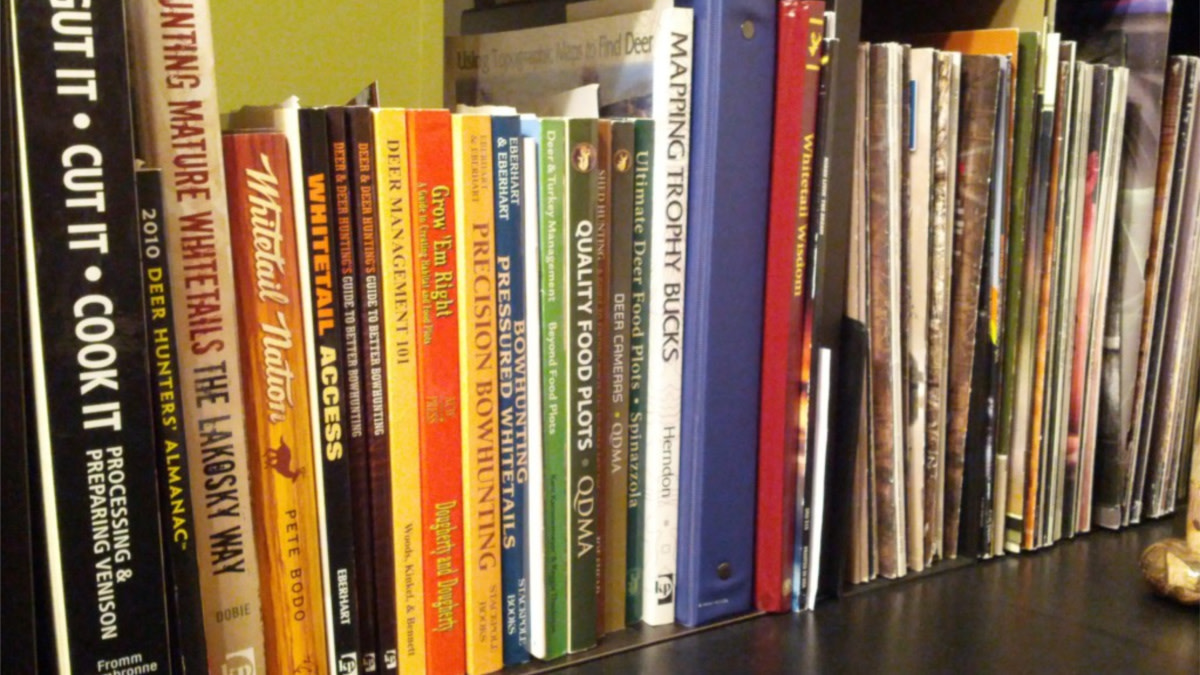
I’m painfully frugal about most things. For example, I’m still sleeping on the second-hand mattress I inherited after college 13 years ago—a point of bitter dispute with my wife. But there is one product which I am uniquely liberal with my funds: books.
I always give myself permission to buy books.
Books open doors to new worlds, ideas, solutions, and perspectives. They lead to growth. This is, in my view, the single best investment we can make in ourselves and as hunters.
Last year I wrote about the four books every whitetail hunter should read, but soon after realized the list wasn’t long enough. Here are four more that might help with your hunting journey, whether you want to be a public land killer, habitat manager, or understand the paradoxical collision of loving wild animals while also hunting them.
“Whitetails: From Ground to Gun” by Neil and Craig Dougherty
What stands out most about “From Ground to Gun” is that there’s a little something here for everyone. The father-son duo have created a comprehensive guide to better deer hunting and management with a choose your own adventure element.
If you own or hunt managed properties, you’ll find value in the Dougherty’s best-in-class recommendations for evaluating and improving whitetail habitats. On the flip side, if you hunt by-permission or on public lands, you’ll surely gain something from the Dougherty’s “7 Habits of Highly Effective Deer Hunters.” And every hunter will find value in their talk of how wind and thermals should impact your hunting strategy.
“Precision Bowhunting” by John & Chris Eberhart
No book was more transformative for me in my early years as a deer hunter than “Precision Bowhunting.” It’s no exaggeration to say that you could look at my hunting journey as split in two halves with “Precision Bowhunting” as the inflection point. Suffice to say, the second half of this journey has featured a whole lot more venison in the freezer.
John and Chris Eberhart, another renowned father-son duo, have made their living helping hunters kill deer on heavily pressured ground. This book details exactly how to do that, with month-by-month instructions and a focus on the impacts of human pressure on deer and hunting strategy. While I don’t ascribe to every one of the Eberharts’ principals, their detail-oriented philosophy and focus on properly timed hunts stays with me even today.
“Whitetail Success by Design” by Jeff Sturgis
“Whitetail Success by Design” is another foundational text in my deer hunting library—but one with a very different focus from “Precision Bowhunting.” This text emphasizes the importance of land management, and what sets it apart from most whitetail land improvement books is its strategic focus. Other resources might recommend what food plot to plant or how to improve cover. “Whitetail Success” takes things a step further by exploring where such improvements should go, how they will interact with other property elements, and how all of the above can influence deer movement and hunters.
No change to wildlife habitat exists in a vacuum. Every action leads to a reaction. Understanding this cascading flow of impacts is of the utmost importance to a hunter hoping to improve a property. Sturgis explores of all of this in great detail and in a manner better than any other habitat book I’ve read. It links land improvements to smart hunting strategy.
“A Thousand Deer” by Rick Bass
If there’s one thing that can connect hunters, it is the joy, reverie, and nostalgia of a good hunting story. There are few better at spinning just such yarn than Rick Bass.
“A Thousand Deer” is a collection of stories revolving around the author’s experiences as a young man, geologist, deer hunter, father, and naturalist across the landscapes of Texas, Montana, and beyond. Written with true aim and elegance, Bass’ hunting stories put words to experiences that many of us have had, but couldn’t quite articulate. He sees truth in ideas, people, places, and animals around him and transports them to the page plainly for all to see. Consider the following excerpt:
“Many hunters believe—have always believed—that it is not the skill of the hunter that brings game to the hunter—no human could ever be as wary or cunning as a wild animal—but rather, that the animal comes as a gift of the land: that it is an act of good luck, grace—a presentation. And that the good hunter always remembers this, and is always grateful, amazed by and marveling at his luck—at the beautiful, intricate specificities of it. And I’d have to agree: with every deer I’ve ever killed, that’s always how it’s been. The mountain delivers a deer to you. Like something eroding slowly, the mountain shed itself of one deer, but sends it not randomly downslope, but in your direction. It’s easy to say thank you. It’s the easiest part of hunting.”



